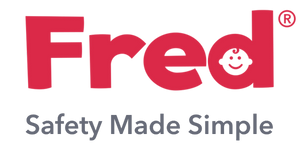27% of UK parents state that their children have injured themselves by hitting their heads on table corners. Yet many parents still do not have all of these sharp corners and potential hazards covered within their homes. Fred is on a mission to reduce these statistics.
This will blog will cover:
- Real Accidents, Real People: Oscar’s Story
- The Dangers Of Bumped Heads
- How Fred is Preventing Accidents Like This One
Real Accidents, Real People: Oscar’s Story
In his mother's own words 'It was a nursery day and the boys were dressed and ready to go when I left for work. Their Dad was at home doing the last bits like getting their shoes and coats on, etc. I had only been driving for a few minutes when my husband called to say come home, Oscars banged his head and he's bleeding really bad.’
Oscar’s parents believe Oscar had wandered off into the playroom. When he began to scream and cry, his father ran into the playroom and found him standing in the ball pit with blood running down his face.
‘We are not entirely sure how it happened but we have some low-level floating bookshelves on the wall next to the ball pit so the kids can just pick the books themselves. So we think he must have jumped into the ball pit and banged his head off the corner of the bookshelves.’
Oscar’s parents took him to A&E. To stop the wound from bleeding, it was glued and had steri strips placed on it. Oscar has about an inch scar above his eyebrow now.
The Dangers of Bumped Heads
Luckily, most head injuries do not require hospital treatment. However, the risk of sustaining a concussion is four times greater in children who have previously had a concussion, compared to those who have not. Symptoms of concussion will generally start within 24 hours. However, it may up to 3 weeks for symptoms to appear.
If your little one is showing any of these symptoms after they have bumped their head, then please contact 111 or your GP:
- Crying persistently more than usual
- Loss of balance
- Poor coordination
- Change of mood
- Nausea
- A lack of energy or interest
- Sensitivity to light and/or noise
- Refusal to eat or drink
- Changes in sleeping pattern
- Rubbing of the head- this could indicate a headache
If your child has had a significant injury to their head or they are displaying the symptoms listed above, please contact 999 or visit A and E. Contact NHS 111 if you are not sure what to do after an accident.
How Fred is Preventing Accidents Like This One
To protect children from sharp corners, the Fred Adhesive Corner Protector is cleverly designed with shock-absorbing corner guards. Fred SecureHold adhesive keeps the protectors firmly in place with an external softer shock-absorbing outer layer. It is discreetly designed, reassuringly child-proof, and made from bite-safe non-toxic food-grade material.

It is common for children to have knocks and bumps as they begin to explore the world around them. It is everyone’s duty to make sure that they can explore the world in a fun but safe way. Protect your sharp corners to minimise the risk of an accident within your home. An accident is a preventable event that with the correct home safety equipment can be avoided.
The Fred Ambassador Programme has been designed by the team at Fred to allow real people who have been affected by an accident within the home to share their stories. In doing so, we hope to spread awareness about the importance of home safety especially for those under the age of 5.
If your little one has been affected by an accident within the home and you wish to share their story, please email hello@cheekyrascals.co.uk to apply to our Fred Ambassador Programme. In doing so, you may be able to prevent an accident like yours from happening to the 40,000 children who will be sent to A and E each year because of preventable accidents within the home.


